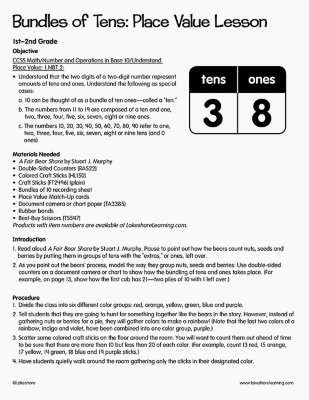Narrow by Grade
- Infant (0)
- Toddler (0)
- Preschool (0)
- Pre-K (1)
- Kindergarten (1)
- 1st (1)
- 2nd (1)
- 3rd (0)
- 4th (0)
- 5th (0)
- 6th & Up (0)
Grade 2nd
Narrow by Age
- 0-18m (0)
- 18-36m (0)
- 3 yrs. (0)
- 4 yrs. (0)
- 5 yrs. (0)
- 6 yrs. (1)
- 7 yrs. (1)
- 8 yrs. (0)
- 9 yrs. (0)
- 10 yrs. (0)
- 11 yrs. & Up (0)
Age
1 results for "extra"
Filters
Clear All
Bundles of Tens: Place Value Lesson
1st Grade - 2nd Grade
Objective CCSS Math/Number and Operations in Base 10/Understand Place Value: 1.NBT.2: Understand that the two digits of a two-digit number represent amounts of tens and ones. Understand the following as special cases: 10 can be thought of as a bundle of ten ones—called a “ten.” The numbers from 11 to 19 are composed of a ten and one, two, three, four, five, six, seven, eight or nine ones. The numbers 10, 20, 30, 40, 50, 60, 70, 80, 90 refer to one, two, three, four, five, six, seven, eight or nine tens (and 0 ones). Materials Needed A Fair Bear Share by Stuart J. Murphy Double-Sided Counters Colored Craft Sticks Craft Sticks (plain) Bundles of 10 recording sheet Place Value Match-Up cards Document camera or chart paper Rubber bands Best-Buy Scissors Introduction Read aloud A Fair Bear Share by Stuart J. Murphy. Pause to point out how the bears count nuts, seeds and berries by putting them in groups of tens with the “extras,” or ones, left over. As you point out the bears’ process, model the way they group nuts, seeds and berries: Use double-sided counters on a document camera or chart to show how the bundling of tens and ones takes place. (For example, on page 13, show how the first cub has 21—two piles of 10 with 1 left over.)
View Lesson Plan